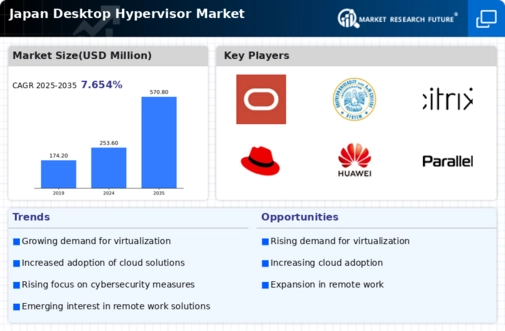The desktop hypervisor market in Japan is characterized by a dynamic competitive landscape, driven by rapid technological advancements and increasing demand for virtualization solutions. Key players such as VMware (US), Microsoft (US), and Oracle (US) are at the forefront, each adopting distinct strategies to enhance their market presence. VMware (US) focuses on innovation through continuous product development, particularly in cloud integration and security features, which positions it as a leader in providing comprehensive virtualization solutions. Microsoft (US), leveraging its Azure cloud platform, emphasizes seamless integration of its hypervisor solutions with cloud services, thereby appealing to enterprises seeking hybrid cloud capabilities. Oracle (US) adopts a strategy centered on optimizing performance for enterprise applications, which is crucial for organizations with demanding workloads. Collectively, these strategies contribute to a competitive environment that is increasingly centered on technological differentiation and customer-centric solutions.
In terms of business tactics, companies are increasingly localizing their operations to better serve the Japanese market, which is known for its unique business culture and technological preferences. Supply chain optimization remains a critical focus, particularly in ensuring the reliability of software updates and support services. The market structure appears moderately fragmented, with several players vying for market share, yet dominated by a few key firms that significantly influence pricing and innovation trends.
In October 2025, VMware (US) announced a strategic partnership with a leading Japanese telecommunications provider to enhance its cloud services offerings. This collaboration is expected to facilitate the deployment of VMware's hypervisor solutions across a broader range of industries, thereby expanding its footprint in the region. The strategic importance of this partnership lies in its potential to leverage local expertise and infrastructure, which could significantly enhance service delivery and customer satisfaction.
In September 2025, Microsoft (US) launched a new version of its hypervisor, which integrates advanced AI capabilities for better resource management and optimization. This move is particularly significant as it aligns with the growing trend of AI integration in IT solutions, allowing businesses to automate processes and improve operational efficiency. The introduction of AI features may provide Microsoft with a competitive edge, appealing to tech-savvy enterprises looking to enhance their virtualization strategies.
In August 2025, Oracle (US) unveiled a new initiative aimed at enhancing security features within its hypervisor solutions, responding to increasing concerns over data breaches and cyber threats. This initiative is crucial as it addresses a pressing need for robust security measures in virtualization environments, potentially attracting customers who prioritize data protection. By focusing on security, Oracle positions itself as a trusted provider in a market where data integrity is paramount.
As of November 2025, the competitive trends in the desktop hypervisor market are increasingly defined by digitalization, sustainability, and the integration of AI technologies. Strategic alliances are becoming more prevalent, as companies recognize the value of collaboration in enhancing their service offerings and market reach. Looking ahead, competitive differentiation is likely to evolve from traditional price-based competition to a focus on innovation, technological advancements, and the reliability of supply chains. This shift suggests that companies that prioritize R&D and customer-centric solutions will be better positioned to thrive in an increasingly complex market.






















Leave a Comment